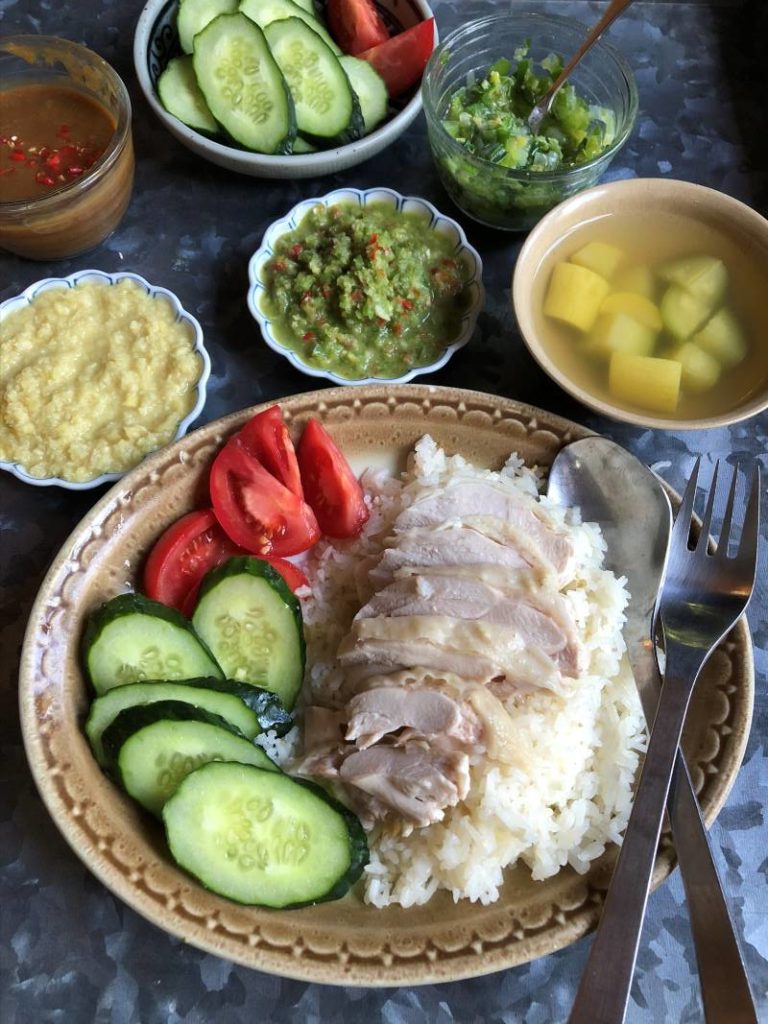
I used to be able to get two big meals from one whole chicken, but recently, one whole roast chicken lasted four or five meals for us. Granted, we’re a small household, but we find ourselves consuming more vegetables these days than animal protein. As a result, I started cooking half chickens. Last week, there was a chicken sale and I was all over it. But instead of one dish, I figured I could make two, maybe three dishes from a big bird weighing nearly five pounds. I asked the friendly butcher to cut the chicken in half and remove the backbone for me. My goal was to turn one half of the bird into Hainan chicken and rice, a favorite in Singapore, Malaysia, and Thailand. In Vietnamese, it’s called cơm gà Hải Nam. (What to do with the other chicken half? Grill, roast or braise it! Make a totally different dish.)
Hainan is an island off the southeastern coast of China. Tradition cooks poach a particular breed of chicken called the Wenchang chicken that seems to be akin to a stewing hen; it's bony and tough. Chickens are precious in Old World cuisines (one bird is better off laying eggs than being serve at the table!), so a dish that sacrificed a chicken was special. As Hainanese people migrated throughout Southeast Asia, so did their chicken and rice traditions. Here’s a brief history from Singapore; there's more information in this article on Next Shark.
I’ve eaten the gingery poached chicken and rice plate at Singaporean hawker centers (Tian Tian is good as they say) and at Nong’s Khao Man Gai, a famed Thai food cart turned brick-and-mortar mini chain in Portland, Oregon. But I also make Hainan chicken and rice at home. It’s time consuming because of all the sauces, but it doesn’t require many ingredients. And you can cook the chicken up days in advance. Ditto for the rice and sauces. Just bring everything to room temperature before serving.
Bird Notes
The conventional version of Hainan chicken and rice goes down like this: poach a whole chicken till it’s slightly pink at the bone, use the broth and fat to make a gingery, garlicky rice, and serve extra broth as a soup. Thick slices of cucumber and wedges of tomato add refreshing notes.
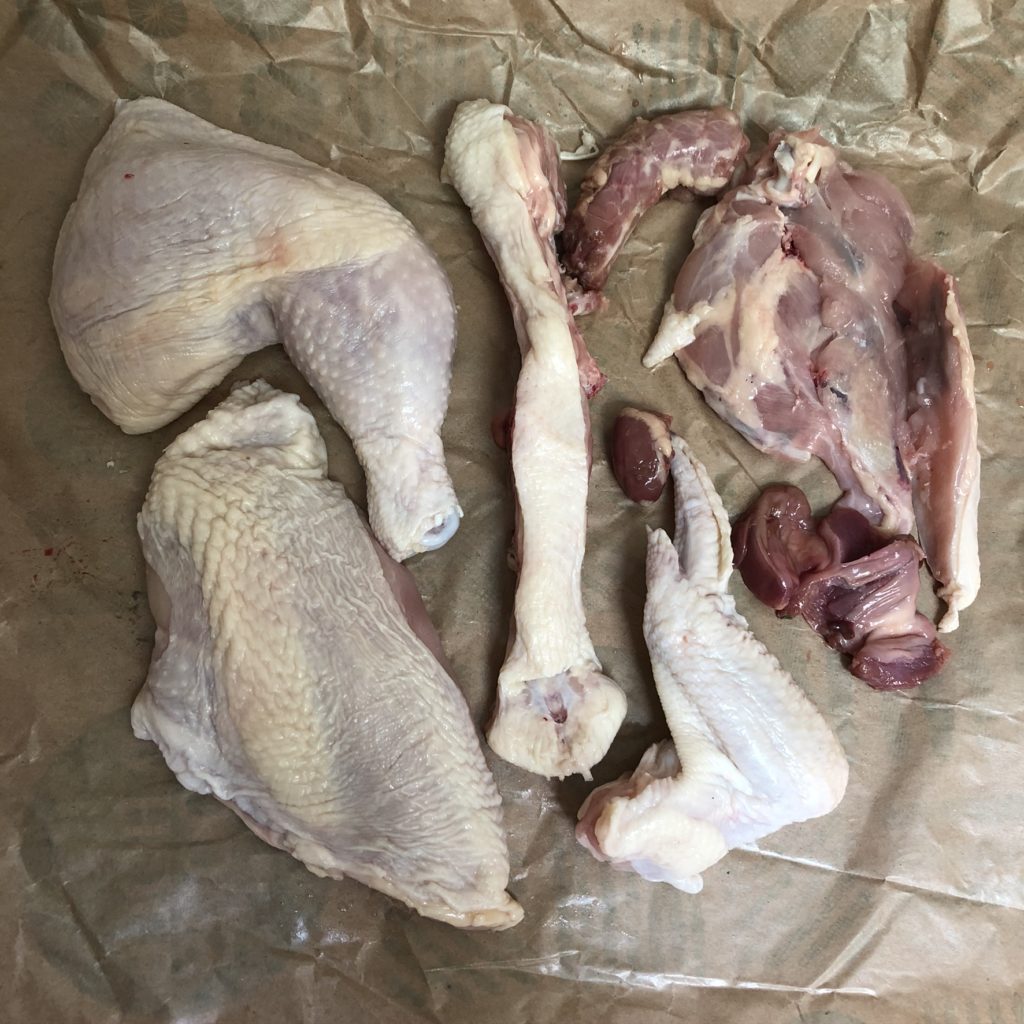
My problem has been that the broth isn’t that flavorful. That's because the bird is very gently cooked and then hacked up for serving. The cooking liquid is exceptionally light. The advantage to cooking with half a bird is this: whatever spare parts you have, put it into the broth to create good flavor. (See the photo above for what I put in; I omit the liver because it can add an off flavor.) Once the chicken is done poaching on no-heat, reheat the pot to simmer the broth a little extra for deeper savory goodness.
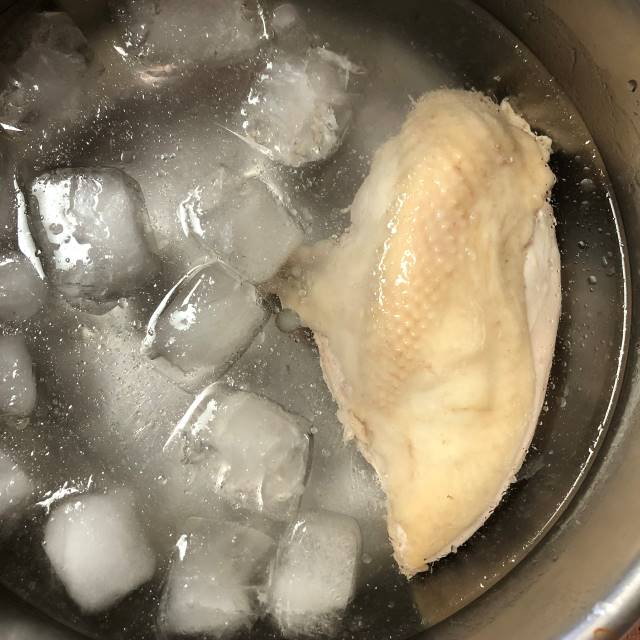
Ice down the chicken when it's done. That arrests cooking but also creates a firmer finish on the skin. Few people enjoy flabby greasy boiled chicken skin. If you don’t like the skin, you may harvest it and fry it up into chicken fat and cracklings.
Sauce Options
You only need one or two sauces. I got carried away this week and made four (4) sauces: a fresh ginger sauce, spritely chile sauce, savory-tangy-spicy fermented soybean sauce, and rich green onion-ginger sauce.
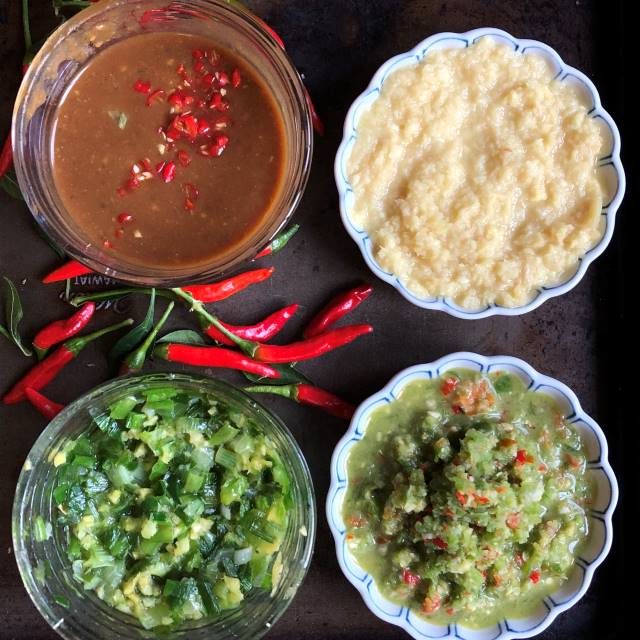
There’s also a sweet soy sauce that you may opt for too. just head to this Hainan chicken and rice recipe that I wrote up years ago.
The sauces are not difficult to prepare and you can do most of them in a small food processor like this one.
Prep Smart
Do NOT be daunted by the long recipe. Many ingredients are repeatedly used, but I have to list them so you may easily work through the recipe. These basic ingredients are what you need:
- Half large chicken plus back bone, about 2 ¾ pounds (cut from a 5-pound chicken)
- 4 ounces ginger, peel using a vegetable peeler
- Cloves from 1 head of garlic
- 1 bunch green onions (about 6 medium ones)
- Fine sea salt
- Handful (1 ounce) cilantro sprigs
- About ½ cup semi-refined peanut oil or neutral oil, or a 1:1 combination of unrefined peanut and neutral oils
2 medium summer squash, or 1 small seeded opo squash, cut into ¾-inch chunks
Peel the ginger and garlic to start with so you don’t get cranky later on. Since a half chicken doesn’t yield enough fat for the rice, I use oil. I like semi-refined or unrefined peanut oil for fragrance. Asian markets, particularly Chinese ones, sell the semi-refined kind; Lion and Globe as the go-to brand. For unrefined peanut oil, like Spectrum brand, head to a regular supermarket. Unrefined oil can’t be heat too high, which is I blend it with a neutral oil.
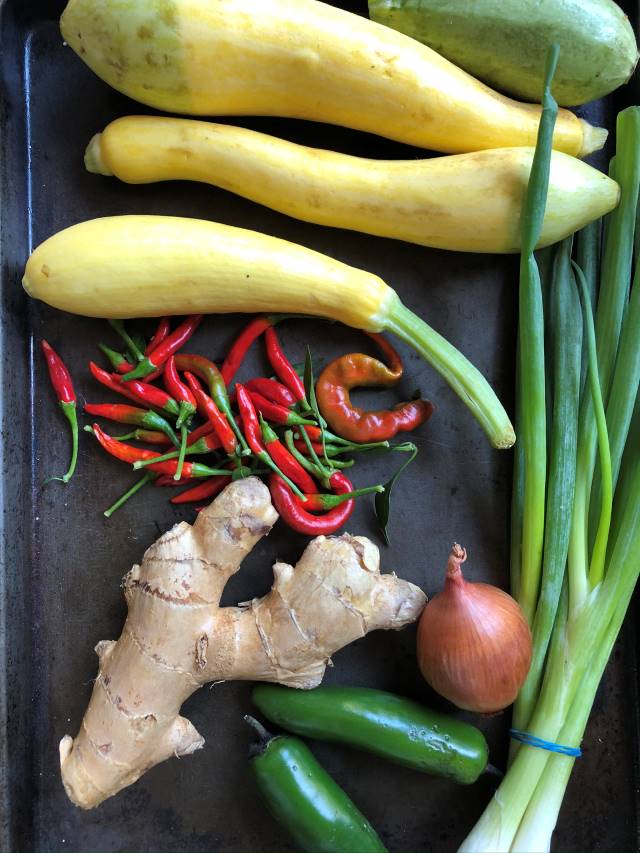
If you want to perfume your rice with pandan, sold frozen or fresh at Southeast Asian and some Chinese markets, go for it! Otherwise, your rice will still be marvelous. Depending on your sauces, you may need all or some of these optional ingredients:
- 4 fresh or thawed pandan leaves, tied together in one loose knot
- 2 or 3 large moderately hot chiles, such as Fresno or jalapeno
3 or 4 hot Thai chiles - 1 lime
- 1 ½ tablespoons coconut, apple cider vinegar, or rice vinegar
- Fermented soybeans or miso (white or red)
- Regular oy sauce
- Honey
- Sugar
So here you go! If you have a Hainan chicken and rice tricks to share, please do. We’re all here to learn.
Hainan Chicken and Rice
Ingredients
For the chicken:
- Half large chicken plus back bone, neck, giblet and other parts from butchering, about 2 ¾ pounds
- 7 cups water
- 1 ½ teaspoons fine sea salt
- 5 quarter-sized slices ginger, peeled or unpeeled, crushed with the broad side of a cleaver or chef's knife
- 2 green onions, white and green parts, cut into 2-inch sections
- 4 or 5 garlic cloves, smashed
- 1 small handful (.5 oz) cilantro sprigs, or 4 fresh or thawed pandan leaves, tied together in one loose knot
For the rice and soup:
- 2 cups raw long-grain rice, such as Thai jasmine
- ¼ cup semi- semi-refined peanut oil or neutral oil, or a 1:1 combination of unrefined peanut and neutral oils
- 1 ½ tablespoons finely chopped shallot
- 1 tablespoon finely chopped fresh ginger
- 2 teaspoons finely chopped garlic
- 2 ½ cups chicken poaching broth
- ½ teaspoon fine sea salt
- 4 pandan leaves, tied in a knot
- 2 medium summer squash, or 1 small seeded opo squash, cut into ¾-inch chunks
Sauce option 1: Ginger sauce
- Chubby 2 ½ inch-section ginger, peeled and thinly sliced
- ¼ teaspoon fine sea salt
- 2 tablespoon chicken poaching broth
- 1 ½ tablespoons semi-refined peanut oil or neutral oil, or a 1:1 combination of unrefined peanut and neutral oils
Sauce option 2: Chile sauce
- 2 large moderately-hot chiles, such as Fresno or jalapeno, coarsely chopped
- 2 or 3 hot Thai chiles, coarsely chopped
- 1 teaspoon chopped garlic
- 2 to 3 teaspoons chopped peeled ginger
- ½ teaspoon sugar
- ¼ teaspoon fine sea salt
- 1 tablespoon fresh lime juice
- 1 tablespoon chicken poaching broth
Sauce option 3: Fermented soybean sauce
- 1 tablespoon packed chopped cilantro stems
- 1 tablespoon chopped peeled ginger
- 2 tablespoons miso (white or red)
- 1 ½ tablespoons coconut, apple cider, or rice vinegar
- 1 tablespoon chicken poaching broth
- 1 tablespoon soy sauce
- 1 tablespoon honey (dark amber kind is perfect)
- 2 red Thai, or 1 Fresno chile, chopped
Sauce option 4: Scallion ginger sauce
- 3 medium, or 2 large green onions, white and green parts, finely chopped
- 1 tablespoon finely chopped peeled ginger
- 1 big pinch fine sea salt
- 2 tablespoons peanut oil refined or semi-refined, neutral oil, or a 1:1 combination of refined and neutral oil
To finish
- English cucumber, sliced on the diagonal into ¼-inch-thick pieces
- tomatoes, cut into ½-inch-wide wedges
Instructions
- Rinse and pat the chicken dry with paper towel. Cut off the wing, then cut off the leg quarter. Debone the breast from the carcass. Cut or break the backbone in half, then put the pieces along with the neck and other spare parts into a 4-quart pot. Add the wing and leg quarter, plus the water. Bring to a simmer, then skim off any scum that floats to the top.
- Add the salt, ginger, garlic, green onion, cilantro. Snuggle the deboned breast into the pot. When the pot returns to a simmer, turn off the heat, make sure the breast is fully submerged (add water if you have to), then cover.
- The breast should be just done at 25 minutes, and the leg quarter at 40 minutes. They should feel just firm. As each chicken part is cooked, transfer it to a bowl of ice water and let it sit for about 8 minutes to cool down quickly, then transfer to plate if serving soon, or an airtight container if storing in the fridge.
- After removing the leg from the pot, return it to a simmer and cook, partially covered, for 45 minutes to create a stronger broth. Strain through a muslin or paper towel-lined strainer and set aside or refrigerate.
- To make the rice, rinse the rice then let it drain in a mesh strainer for 10 minutes. Meanwhile, bring the broth to a near simmer in a small saucepan, and then cover to keep it hot.
- In a 3 or 4-quart pot, warm the ¼ cup oil over medium heat. Add the garlic, ginger, and shallot and cook, stirring constantly, until no longer raw smelling and just starting to turn golden, 1 to 2 minutes. Firmly shake the strainer of rice to expel any hidden water, and then add the rice to the pot. Stir constantly with a large spoon until the grains are opaque white and feel light, about 3 minutes. Reduce the heat slightly, measure out 2 ½ cups of hot broth and add the broth. Expect dramatic boiling. Immediately give the pot a big stir, reduce the heat to medium to simmer.
- Add the salt, and if using, the pandan. Let the rice vigorously simmer for 2 to 3 minutes, stirring 2 or 3 times, until most of the water has been absorbed and the surface looks glossy and thick; small craters/holes may form too. Decrease the heat to low, cover, and cook for 10 minutes. Turn off the heat and let it sit for 10 minutes to firm up and finish cooking. Uncover, fluff with chopsticks or a fork, and then cover. Wait 5 minutes before serving. The rice will stay warm for 30 minutes.
- While the rice cooks, add the squash cubes to the broth and let it gently cook, partially covered. Turn off the heat after about 10 minutes, when the squash is tender, then cover to keep hot.
- Meanwhile, make one, two or all of the sauces, and set at the table. Three of the sauces use a food processor and you don’t have to wash the bowl between sauces. For the ginger sauce, put the ginger, salt, oil, and broth into a small food processor and whirl to a fine texture. Transfer to a dipping sauce dish.
- For the chili sauce, put all the ingredients – both kinds of chiles, garlic, ginger, sugar, salt, lime juice and chicken poaching broth, into the small food processor and whirl to a semi-coarse sauce. Transfer to a dipping sauce dish.
- For the fermented soybean sauce, use the small processor to render the cilantro stems, ginger, fermented soybeans (or miso), vinegar, poaching broth, soy sauce, and honey into a slightly thick sauce. Transfer to a dipping sauce dish and add the chile.
- For the scallion ginger sauce, in a small microwave safe bowl, combine the green onion, ginger, salt, and oil. Microwave on high for about 45 seconds, or until steamy and bubbly. Let cool to room temperature and set at the table with other sauces.
- To serve, cut the chicken into slices about ¼-inch thick, deboning the chicken as needed. Keep the skin for rich, textural contrast, if you like. Arrange the chicken on a plate or atop the rice on individual plates. Ladle the soup into individual bowls. Serve the chicken, rice, soup, cucumber, tomato and all the sauces. Fork and spoon are the primary utensils for this dish.













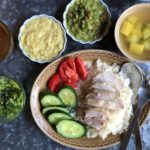


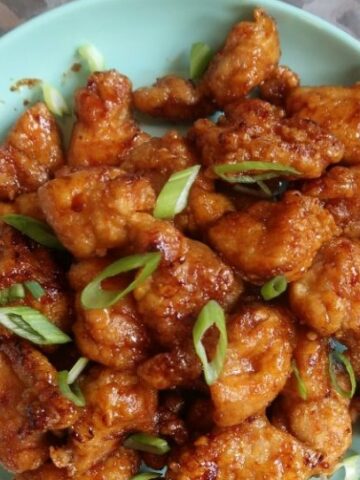

James says
The very essence of a chicken rice is not done correctly let alone to copy the name of Hainan chicken rice ! The fat from the chicken is not extracted to fry along with the rice is not properly done so your rice is not up to standard and the way to poach the chicken is wrong also. Do Vietnamese copy things half way and call themselves publishing recipes and cookbooks as chefs and food critics ? No wonder Vietnamese food have limited variety and are able to be presented on a banquet table to call a proper feast. Just indulge into your way of food preparation is suffice, do not venture outside your cuisine , you can never eat the same flavor of Hainan Chicken rice like in Singapore , go try the Kampung Chicken in Ha Noi , and they charged 3 to 4 times the price of a local Singapore chicken but the taste is bad, rice is cold and not up to standard. It is a shame the locals cannot point out the difference and continued to be cheated by such business operators.
Andrea Nguyen says
James, a bit of chicken fat is nice but home cooks cannot always procure all that fat. You may not have the fat to render, as is the case in this method that utilizes half a chicken. And, sometimes you just want to put good food on the table and it's okay to find workarounds. I understand you're a stickler for tradition and I've eaten the dish in Singapore, as mentioned above. That said, I like to also offer options for folks to get as close as possible.
I wonder what the original Wenchang chicken version is like, before the Hainanese got to Singapore! The link I point to above to the Singaporean history piece is fascinating. Hope you had a chance to check it out.
All of this says that food traditions are flexible as people migrate and make do. What's important is that they understand and appreciate the evolution of food, and that when they're cooking, they cook with thoughtful intention. Personal authenticity matters.
In a prior recipe, I call for chicken fat: https://www.vietworldkitchen.com/blog/2008/04/hainan-chicken.html
Thanks for weighing in.
Kevin Bui says
Such a classy response to an extremely rude, arrogant comment by James lol. James- you're not better than anyone else. I don't understand how mentally unstable you have to be to insult an entire ethnic group based off a chicken rice recipe. I would have handled that much more poorly, Andrea. Thank you for the awesome recipe.
Andrea Nguyen says
You're welcome, Kevin!
chzplz says
"Peel the ginger and garlic to start with so you don’t get cranky later on."
ARE YOU ME???? 🙂
Andrea Nguyen says
Mind meld!
Rhianna says
Do you think I could scale the recipe down and just use thighs? (bone-in, skin-on, of course)
Cindy says
As long as we're talking work-arounds...
When we make a "Thomas Keller's Simple Roast Chicken," we have a ton of chicken left over. We keep the wonderful salty drippings for a take on your original Hainan Rice recipe. The fat we use to sauté the ginger, etc., and the rest we reconstitute to get the chicken broth that both helps flavor the rice and goes into a few of your sauces. The rice, some of the left-over chicken, the sliced veggies, the sauces... we think it's Hainan Rice heaven! (But I'm afraid I've probably driven poor James to despair.)
As long as we're talking about your wonderful recipes, though, another thing we do with the left-over chicken is use it to make your Sichuan cold sesame noodles. Yum!
With your recipes, we easily - and happily! - make a roast chicken last most of the week!
Andrea Nguyen says
Cindy -- what a fabulous repurposing idea. That's perfect. Man, the roasty fat would make the rice sing super high note. Brilliant!